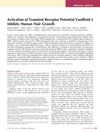TLDR Olmsted syndrome can be inherited as an autosomal recessive trait due to a rare TRPV3 gene mutation.
The study identified a homozygous recessive mutation in the TRPV3 gene, specifically c.1562G>C, as a cause of a severe form of Olmsted syndrome (OS) in a 2-year-old patient of Arab Muslim origin. This mutation was associated with symptoms like painful palmoplantar keratoderma and hyperkeratotic plaques. It was not found in 250 healthy individuals or in large genetic databases, indicating its rarity and potential pathogenicity. The study concluded that OS could be inherited as an autosomal recessive trait, in addition to the previously known dominant and X-linked recessive patterns, thus broadening the understanding of its genetic basis.
88 citations
,
April 2012 in “Journal of Investigative Dermatology” Blocking TRPV3 may help treat itch in dry skin conditions.
 105 citations
,
May 2011 in “The journal of investigative dermatology/Journal of investigative dermatology”
105 citations
,
May 2011 in “The journal of investigative dermatology/Journal of investigative dermatology” Activating TRPV3 stops human hair growth.
9 citations
,
August 2021 in “Journal of clinical medicine” Pili torti is a rare condition where hair is twisted and breaks easily, often linked to genetic disorders or other health issues.
 December 2024 in “Frontiers in Genetics”
December 2024 in “Frontiers in Genetics” EGFR and mTOR inhibitors may help manage Olmsted syndrome symptoms.
 2 citations
,
May 2023 in “International Journal of Molecular Sciences”
2 citations
,
May 2023 in “International Journal of Molecular Sciences” The TRPV3 ion channel is important for skin and hair health and could be a target for treating skin conditions.
5 citations
,
May 2017 in “Journal of dermatological science” The combined treatment effectively managed severe skin issues in Olmsted syndrome.
 25 citations
,
July 2019 in “Experimental Dermatology”
25 citations
,
July 2019 in “Experimental Dermatology” Cholesterol balance is important for hair health, and problems with it can lead to hair loss conditions.




